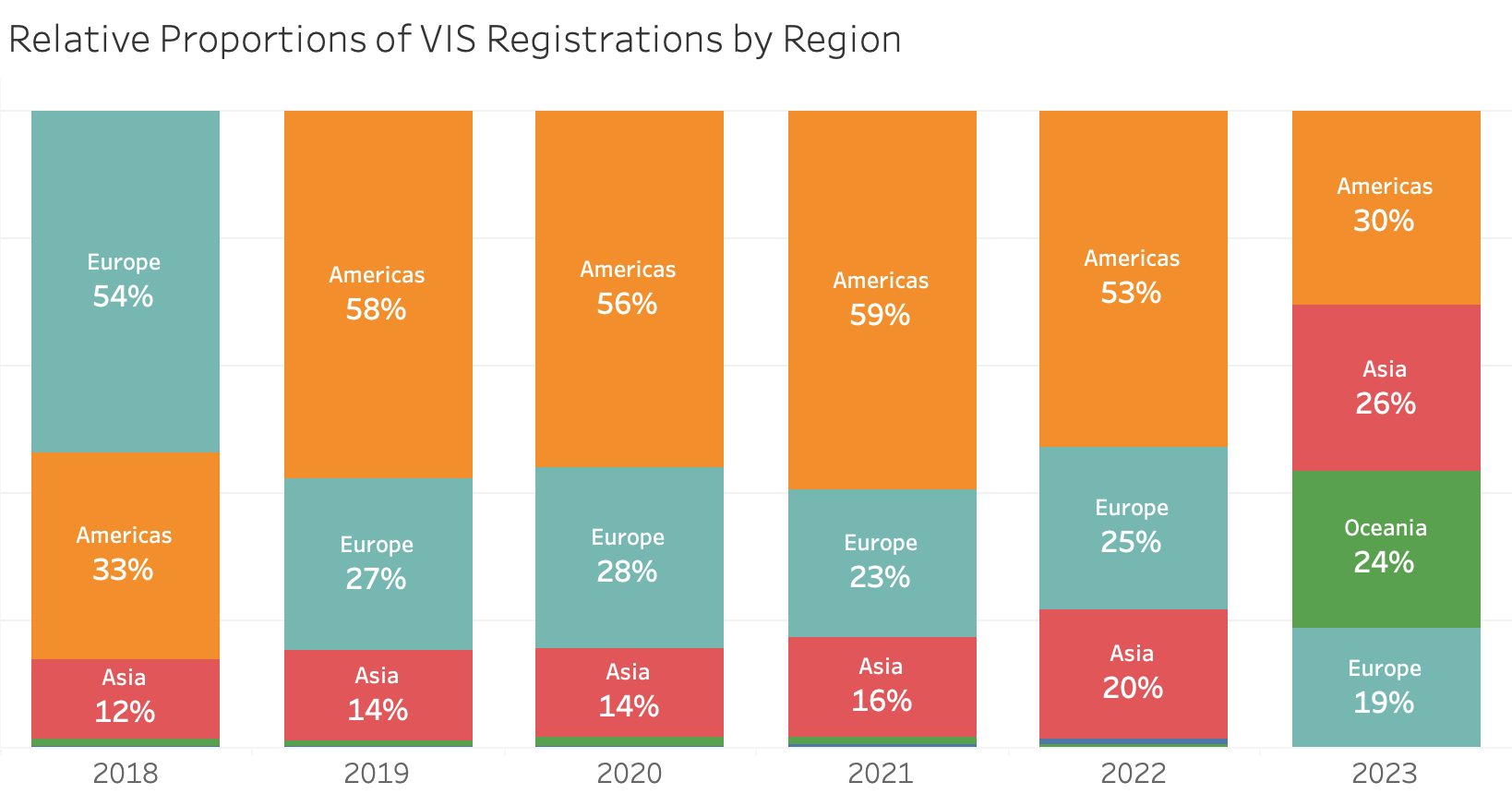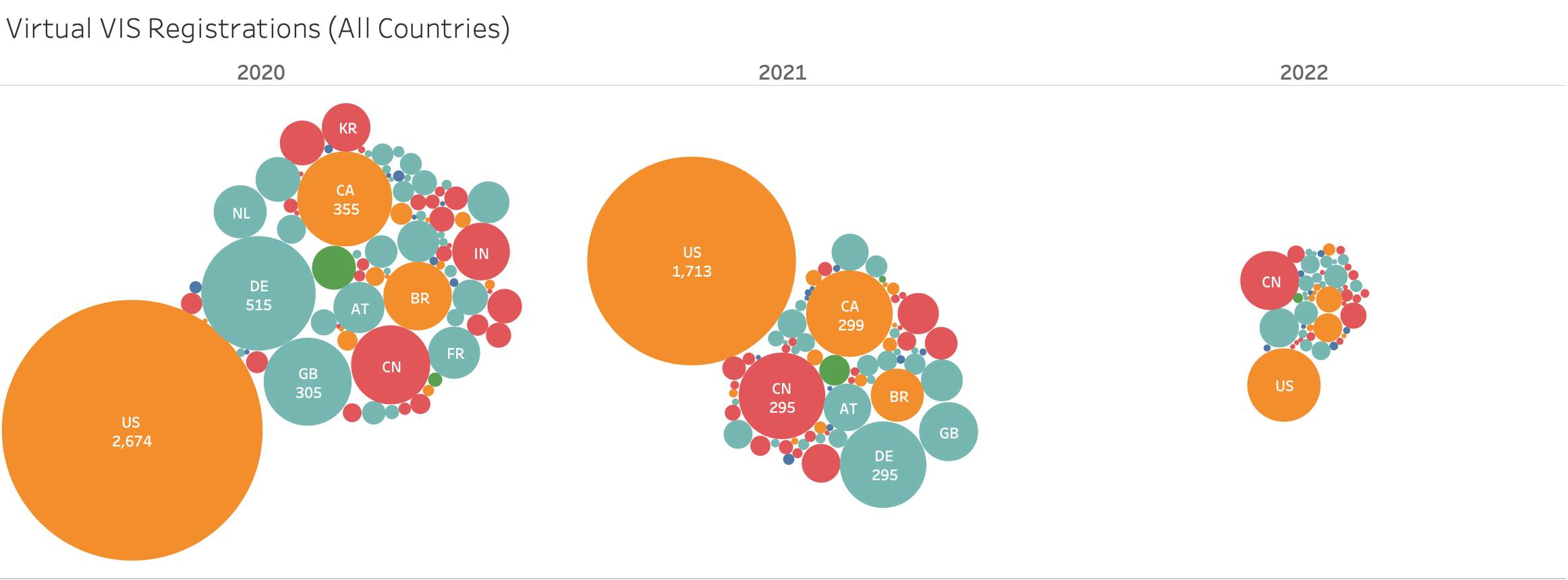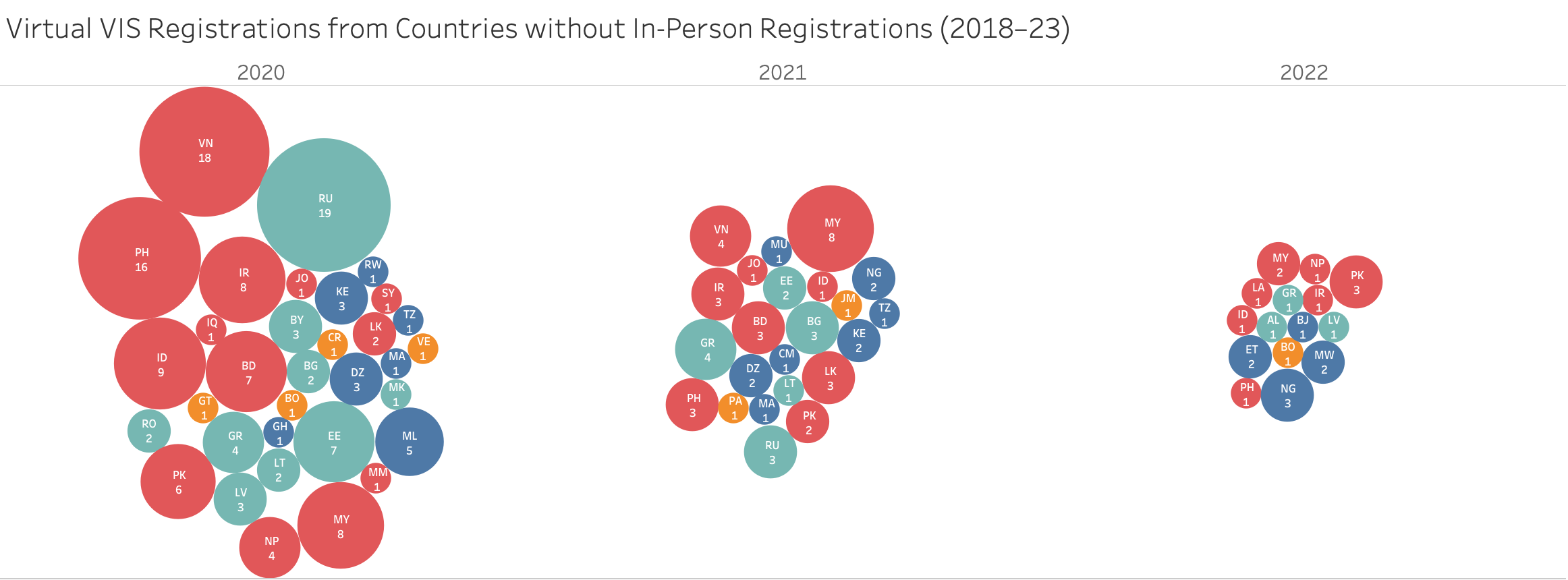In the previous post by the The VIS Executive Committee (VEC), we outlined our initiative to investigate the wicked problem of planning future VIS conferences, focusing on the extent to which the conference should assume a hybrid format or consider other alternative formats to broaden participation, while ensuring positive experiences for both in-person and remote attendees.
We now continue this initiative with an overview of VIS attendance patterns between 2018 and 2023. This period is particularly interesting given the variation in location / time zone and format of VIS during this time:
- 2018: Berlin (in person, GMT+1)
- 2019: Vancouver (in person, GMT-8)
- 2020: Salt Lake City (virtual, in GMT-7)
- 2021: New Orleans (virtual, in GMT-6, with several in-person satellite events around the world)
- 2022: Oklahoma City (synchronous hybrid, GMT-6)
- 2023: Melbourne (in person, GMT+11)
For each year listed above, we collected anonymized registration data aggregated by world region and country. For the synchronous hybrid conference of 2022, we also aggregated the registrations by registration format (in-person or virtual). We acknowledge that when an attendee registers for VIS, their response to the location fields in the registration form may not necessarily represent their country of origin, but rather where they are currently employed or studying. Furthermore, there is no way of verifying if the self-reported country for a person who registered to attend VIS virtually between 2020 and 2022 was the country that they were physically in during the conference. Lastly, we do not currently have any data regarding the level of engagement for virtual attendees beyond registration.
Caveats aside, we report on attendance for the benefit of those considering to make a bid to host VIS in the coming years, VIS organizing committee members planning and scheduling virtual or hybrid program content, as well as for those inclined to host satellite events, such as the eight events that coincided with VIS 2021 or the asynchronous VIS 2023 satellite event in France.
Overall VIS Registration Numbers
VIS 2018 in Berlin remains to be largest VIS conference to date in terms of in-person attendee count (over 1,200), while VIS 2020 had the highest number of virtual registrations (nearly 6,000). We also saw nearly 3,700 virtual registrations in 2021 and nearly 700 in 2022 (the latter also had over 600 in-person attendees). Most recently, VIS 2023 attracted over 800 in-person attendees.

VIS Attendance by Region
Irrespective of the means of attendance (in-person / virtual), we saw some notable differences in terms of the proportion of attendees from different world regions (◼︎ = Europe; ◼︎ = Americas; ◼︎ = Asia; ◼︎ = Oceania; ◼︎ = Africa).

When VIS was in Germany (2018), a little over half of the attendees were based in Europe and made the short trip to Berlin; about a third flew in from North America, just over 10% flew in from Asia, and 1% traveled from somewhere else. The next year (Vancouver), the relative proportions of Europeans and North Americans inverted. Notably, over the next three years, the relative proportions of attendees from North America, Europe, and Asia remained somewhat stable. While the VIS program was virtual in 2020 - 2021 and hybrid in 2022, recall that each program was scheduled in time zone that was convenient for those in North America. Finally, at the most recent VIS conference in Melbourne, which had no virtual attendance option, we saw a fairly even split in terms of who made the trip to Australia: about 30% flew in from North America, 26% came from Asia, 24% were based in Oceania, and 19% made the long trip from Europe.
Virtual VIS Attendance
A couple of questions arise from our virtual registration numbers: (1) Did VIS have a broader geographic reach during the virtual-only years (2020-21)?; and (2) Who opted to attend the hybrid VIS 2022 conference virtually?

Among the virtual registrations, the majority were from those based in world regions and countries already well-represented at VIS: North America, Western and Northern Europe, and East Asia. However, we made special note of the countries that were not represented among in-person registrations between 2018 and 2023. Countries in Southern and Southeast Asia stand out in this pack, with a total of over 100 registrations between 2020 and 2022. About half as many registrations over this period were from those based in Eastern and Southern Europe. Finally, we saw a relatively small number of registrations from Africa and the Americas outside of North America.

Looking at VIS 2022 in particular, a little over 40% of the nearly 700 virtual registrations were from those based in the Americas, while a little under 30% were based in Asia, and just over a quarter were based in Europe. Across all of these registrations, only a couple dozen (~3%) were from those based in countries that had no in-person representation across the years surveyed.
Implications
Aside from the global COVID-19 pandemic that prevented international in-person gatherings in 2020 and 2021, the registration data by itself doesn’t tell us why participants opted to attend virtually in 2022. Nor does it tell us which factors matter to prospective VIS attendees mulling over whether to attend in person or virtually; this is the focus of our the survey announced in our earlier post, and we will present the results of this survey in a future post. However, the registration data does suggest that there is not a large difference in terms of global representation between in-person and virtual attendees.
While attending a regional satellite event may not be accessible or appealing to those who decide against traveling in person to the main event, the virtual registration numbers suggest that there may be a large enough contingent of people in Europe and East Asia to merit satellite events in those locales when VIS takes place in North America. There may even be a critical mass of people in South Asia and Southeast Asia willing to attend such a regional event.
While just over 40% of the virtual registrations for VIS 2022 were from those based in the Americas, the synchronous virtual conference experience for the remaining ~60% was likely to occur at an inconvenient time of day. To accommodate virtual attendees of future VIS conferences, organizers should consider the benefits and trade-offs of asynchronous or partially-synchronous virtual attendee experiences. For example, let’s imagine a future VIS conference hosted somewhere in North America. Presentations delivered by in-person attendees could be recorded during the day and uploaded in the evening, at which point they could be viewed asynchronously by remote attendees. Early the following morning, those whose talks were recorded could join a moderated virtual Q&A session with remote attendees in Europe and Africa, and later that day, they could join a second moderated virtual Q&A session with remote attendees in Asia and Oceania.
At VIS 2024 in Florida, the general chairs have already determined that paper presentation sessions will be split between those delivered by in-person attendees and those delivered by remote virtual attendees. Should this split continue in future VIS conferences, the virtual registration demographics suggest that these virtual-only sessions be scheduled in the early morning and late afternoon / early evening, so as to respect the typical working hours of those attending from around the world.